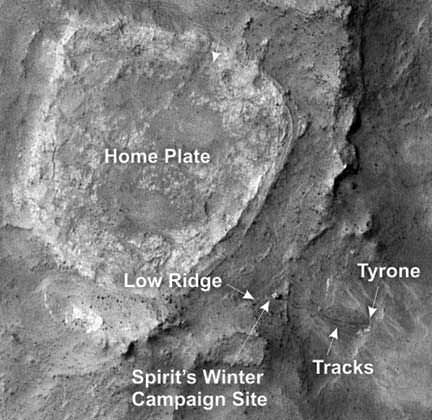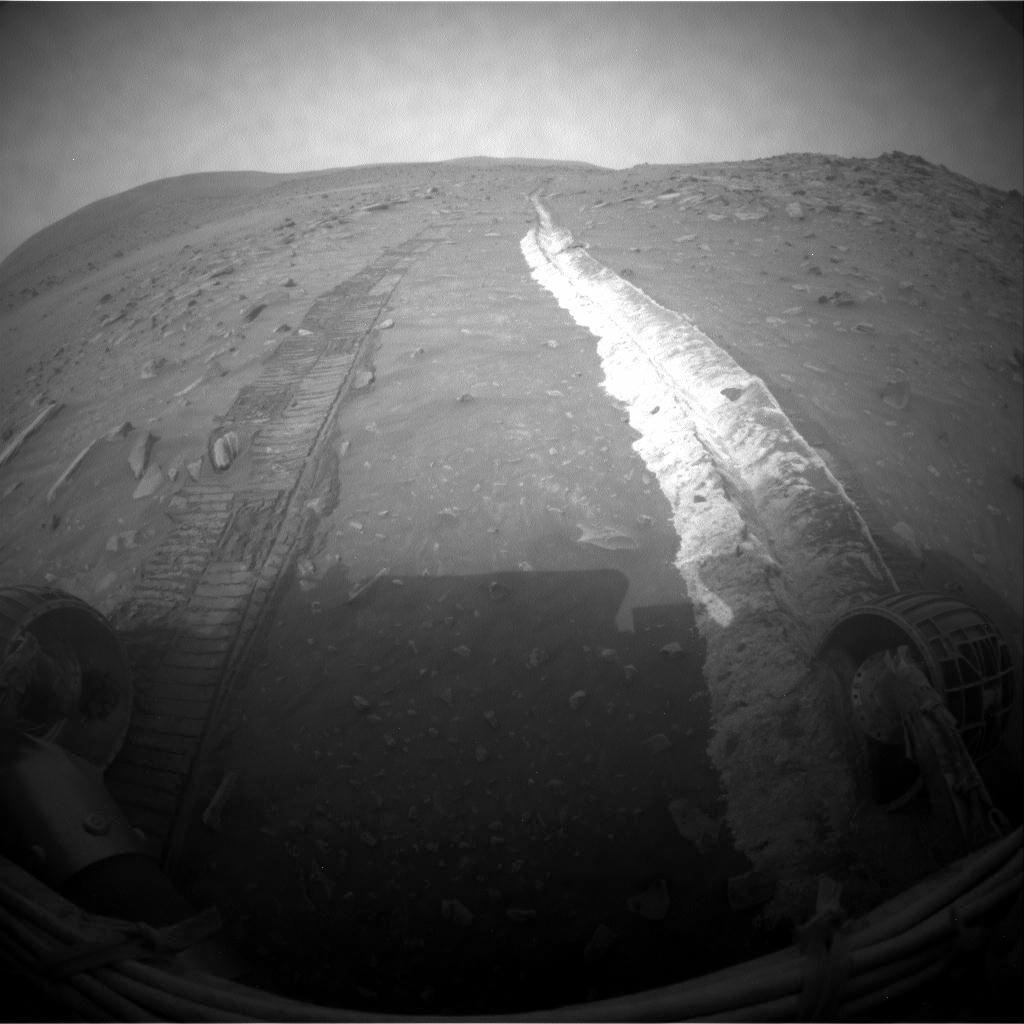[/caption]
The scientists and engineers working with the Spirit rover on Mars were hoping the aging rover could take the short route over the top of a small plateau called “Home Plate;” she could get to her next destination quicker and easier. But with the rover’s right front wheel not working, the rover was unable to make the climb from the side of the plateau where Spirit spent the majority of the Martian winter (with her solar panels tilted towards the sun) up to the top. So, Spirit is now making her way around Home Plate, where the less desirable path may have led to a serendipitous discovery. The rover’s immobile right-front wheel has churned up a long stripe of bright soil. Could this bright soil be sulfur or silica, providing evidence of past action of water at this site? The rover will test the soil today with it’s alpha particle X-ray spectrometer. And this isn’t the first time Spirit’s bum wheel has churned up something interesting.
In 2006, Spirit uncovered another patch of bright soil. The material was found to be sulfur-rich and consisted of sulfate salts associated with iron, and likely calcium. “This material could have been left behind by water that dissolved these minerals underground, then came to the surface and evaporated, or it could be a volcanic deposit formed around ancient gas vents,” said Dr. Ray Arvidson back in 2006. He is the deputy principal investigator for NASA’s twin Mars rovers, Spirit and Opportunity.

“These salts could have been concentrated by hydrothermal liquid or vapor moving through the local rocks,” said rover science team member Dr. Albert Yen, a geochemist at JPL. Two other patches of bright soil uncovered by Spirit before were also sulfur-rich, but each had similarities to local rock compositions that were different at the three sites, suggesting localized origins.
This most recent discovery was made on the 1,861st Martian day, or sol, of Spirit’s mission on Mars (March 28, 2009). After the drive, the rover took the image above with its front hazard-avoidance camera, looking back at the tracks from the drive.
As usual since losing the use of its right-front wheel in 2006, Spirit drove backwards, and the immobile right-front wheel turned up the soil.
The Sol 1861 drive took the rover past the northwest corner of the low plateau called “Home Plate,” making progress on a route around the western side of Home Plate. The edge of Home Plate forms the horizon on the right side of this image. Husband Hill is on the horizon on the left side. For scale, the parallel rover wheel tracks are about 1 meter (40 inches) apart. The rover’s hazard-avoidance cameras take “fisheye” wide-angle images.
Source: JPL’s Photojournal


Me thinks… all future Rovers (Mars or elsewhere) should have a dragging thingy attached.
So… Is Spirit in reverse gear? Surely, that picture is the rear view which would mean that the left front wheel is churning up the soil, unless Spirit was going backwards. Or am I dumb?
Tim- The article says, “As usual, since losing the use of its right-front wheel in 2006, Spirit drove backwards, and the immobile right-front wheel turned up the soil.” Yes, she’s driving backwards. and the rear hazard avoidance camera took the picture.
I’m praying it is not perchlorate!!
Salacious! Perchlorates are totally ok! Don’t let the media convince you otherwise! There are millions of life forms metabolizing percholorate on the very planet on which you stand. Or at least that I think you stand…
I am guessing 800g per litre by the look of it – what didn’t evaporate froze and may even sublimate before the observation in made!
*Especially* because it is on one side of a mesa!!
~]3
I reckon that all future rovers should come fitted with a hoe attachment.
Or an miniature triangular plow to drag behind the rover. Retractible and hinged so as to avoid anchoring on difficult terrain.